Introduction
Australia is one of the most urbanized nations in the world. Nine out of ten Australians reside in only 0.22% of the continent’s land area (Ritchie & Roser 2019). Currently, the government responds to population growth in urban areas by taking either a greenfield (redevelopment in establishment areas) or a brownfield approach (low-density housing on the periphery) (Commonwealth of Australia 2016). Changes raise concerns about the possibility of sustainable development that would include best practices for governance, design, livability, economic prosperity, and environment. Besides objective numbers and figures, urban development also has an impact on the psychology of residents, encouraging or discouraging them from forming a sense of community.
Today, there are specific targets where local governments plan to boost development, which includes Sydney, Melbourne, South-east Queensland, Perth, and Adelaide (Commonwealth of Australia 2016). The area chosen for the current research is Ryde, which is located in the North Sydney region, approximately 13km from the Sydney Central Business District CBD. The suburb itself is at the center of the local government area of the city of Ryde which also consists of North Ryde, West Ryde, Eastwood, and Gladesville. With a population of approximately 131,271, Ryde is a key residential area of Sydney, positioned conveniently between Parramatta (the west) and the city (CBD) with additionally good transport services to both places (Australian Bureau of Statistics 2016).
The New South Wales state government has long been criticized for pushing for development beyond planning norms. Various Members of Parliament argued that the government’s plans disrupt the day-to-day lives of its residents rather than enhance them (Fuller 2019). Therefore, our initial research question “How has development affected the sense of community in Ryde?” strongly reflects the current climate in Ryde, with new developments and projects being introduced frequently in the last few years.
Literature Review
Social sciences point out several types of communities: community as a place, community as relationships, and community as collective political power (Chavis & Wandersman 2002). A sense of community is a term that is commonly used to describe the relationship between an individual and a social structure (Chavis & Wandersman 2002). It is closely related to the perception of the environment, which refers to the judgments that residents make about its perceived qualities, residents’ satisfaction, existing problems, and other aspects.
The sense of community or the lack thereof is paramount to shaping the psychological portrait of a nation and improving public health (Mullins et al. 2001). Darlaston-Jones (2007) writes that for many diseases, traditional epidemiological factors explain only about 40% of their variance, while the remaining 60% can be ascribed to the physical and social environment. Scuderi (2005) supports this claim further by showing that conventional models of patient rehabilitation that include education, diet, exercise, and medication are not as effective if individuals lack support from their community. Furthermore, Lee and Cubin (2002) showed that community cohesion and a sense of belongingness may serve as protective factors against chronic diseases. To sum up, the existing body of research proves that the sense of community is a buffer against physical diseases and social ills; it allows safe self-expression and collaboration and facilitates adjustment.
Taking these facts into consideration, it is only natural to inquire what makes a community a safe haven for its residents and promotes a sense of belongingness. Chavis and Wandersman (2002) demonstrate the existence of a relationship between environmental qualities, the social environment, and residential satisfaction. A more recent study by Smith (2011) confirms these assumptions: according to her, physical factors are important in shaping the positive perception of the environment, alongside the social factors. Smith (2011) examined the Ellenbrook community in Western Australia and found that if an area that is developed with sensitivity and responsiveness to residents’ needs leads to high residential satisfaction.
A study conducted in Brisbane, Australia, assigned a more significant role to dwelling position, design, and facilities, i.e. physical factors, than social-environmental qualities (Buys & Miller, 2012). The researchers discovered that high-density urban development, which is a typical response to population growth in Australia nowadays, leaves people generally dissatisfied. Conversely, as found by Abass and Tucker (2018), Australian low-density neighborhoods were responsible for a higher level of happiness among their residents, to the extent that they were content with street types, tree coverage, sidewalks, shared open- and community spaces.
The sense of community often translates into action necessary for maintaining and developing the area. Chavis and Wandersman (2002) argue about the existence of a process for enhancing the quality of life that, in literature, is often dubbed as “community development,” “community building,” and “community organization.” The driving force of community development is its residents’ voluntary participation in activities that produce goods, be it professional associations, churches, unions, or support groups.
Residents that find that they lack feelings of security, order, and friendliness in their community are less inclined to interact with others and participate in shared activities. In contrast, place attachment and a person’s identification with the place of the residence resulted in a higher level of participation that is essential for forging community identity and making it not only a physical but also an emotional space to be (Brown et al. 2003; Cuba & Hummon 2009).
As for the demographic and socioeconomic factors of community participation, Brown et al. (2003) report that it is older homeowners that tend to be more attached to the place. Race was not found to be a significant predictor of place attachment, at least within the study sample. The findings made by Saegert and Winkel (2004) are consistent with those by Brown et al. (2003): they clearly suggest that homeownership predicts interaction and participation. However, Saegert and Winkel (2004) note that it is not only the individual status that serves as a determinant of community participation but spatial planning as a whole. In particular, scholars opine that residential buildings that provide many opportunities for face-to-face interactions, making connections, and building trust.
Additionally, Cuba and Hummon (2009) note that settlement types may also provide residents with a community identity through place ideologies that contrast community forms, which all can be influenced by the contrasts of housing versus apartment dwelling and private versus public dwellings which may valorize or stigmatize community participation and identity. With regard to Australia, the excessive development in inner Sydney led to under-empowerment among its residents (Searle, 2003). As put by the author, “ “areas in Sydney zoned for higher density residential development, in particular, have generated building scales and densities often significantly greater than those allowed by standards in local plans. This has added a layer of development with little or no community participation (Searle, 2003, p. 6).” The same can be said about Ryde that is exposed to the effects of urban sprawl and overdevelopment.
Methodology
The current research has a quantitative cross-sectional design and utilizes a survey as a form of data collection. The survey itself was tailored to gain an understanding of the attitudes and opinions that residents of Ryde had towards the development in their local area, whether that be increasing or decreasing. In accordance with the literature review findings, we hypothesized that the attitudes must have influenced their perception of community and, in turn, their willingness to participate in community activities. Another major point of interest was the respondents’ sense of community or lack thereof. From the questions we developed, we aimed to identify an association between the development in Ryde and an increase or decrease of the community as perceived by the residents.
The survey was conducted through Qualtrics and dispersed on social media platforms such as Facebook in specific groups related to Ryde and Ryde area residents. At first, we targeted groups such as “North Shore Community” and “Ryde Multicultural Society,” but due to the dissatisfactory response rate, we had to broaden the scope of our search. Broader community pages such as “Ryde Memes” and “Ryde Food Lovers” provided us with a greater number of responses but still lacked a substantial amount to analyze. The last source of data was public surveys, at the local Ryde sporting complex and then at the main shopping center in Ryde (Top Ryde). The current pandemic climate limited our use of face-to-face measures. Ultimately, we concluded our survey with 65 out of 100 responses, which still provided us with enough distinct data and interesting statistics to analyze and use for our research.
As for the ethical considerations, we ensured to include the purpose and background of our research in the brief description of our online survey. Similarly, we communicated the same information to all the respondents that we met in person. All data were confidential and anonymous and distributed only among a limited number of people (our research group). The validity of our research findings was compromised by several limitations. First and foremost, we were unable to reach the desired sample size, which can prevent us from inferring the results onto broader populations.
Furthermore, we included information on age and ethnicity but not on gender, and this decision limited the depth and scope of our study. Another fault with the design of the survey was that we chose to include two open-ended questions rather than one. Indeed, the responses provided us with a more descriptive outlook on Ryde and residents’ attitudes to its changing landscape. Yet, the majority of respondents preferred not to answer them, which made us question the formulation of questions or the necessity to add them to the survey in the first place.
Findings
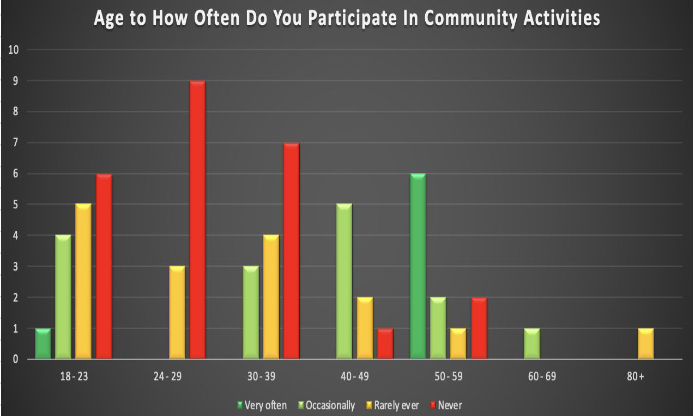
As seen in Graph 1, older age was generally associated with a higher level of participation in community activities. The breakdown shows that the results for the youngest group (aged 18-23) are mixed, with the majority of respondents reporting occasional or very rare participation. The group that is most withdrawn from participating is people between the ages of 24 and 29. After the age of 30 up until 49, the share of people who occasionally participate in activities grows steadily and wanes after the age of 60. Overall, the findings are consistent with Brown et al. (2003) who demonstrated that older age was a reliable predictor of community participation.
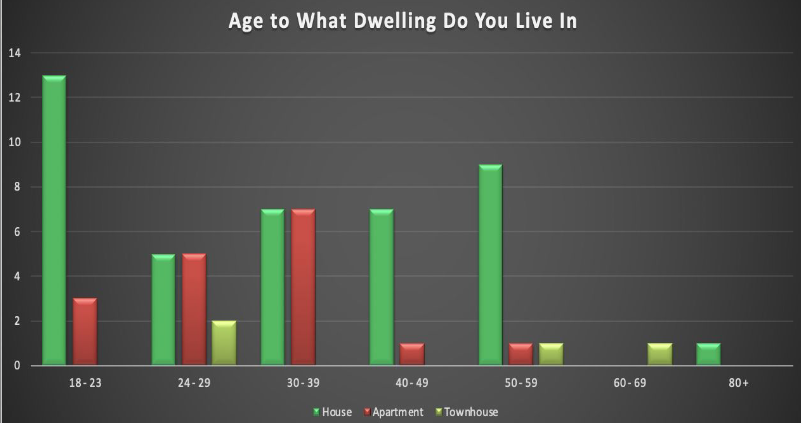
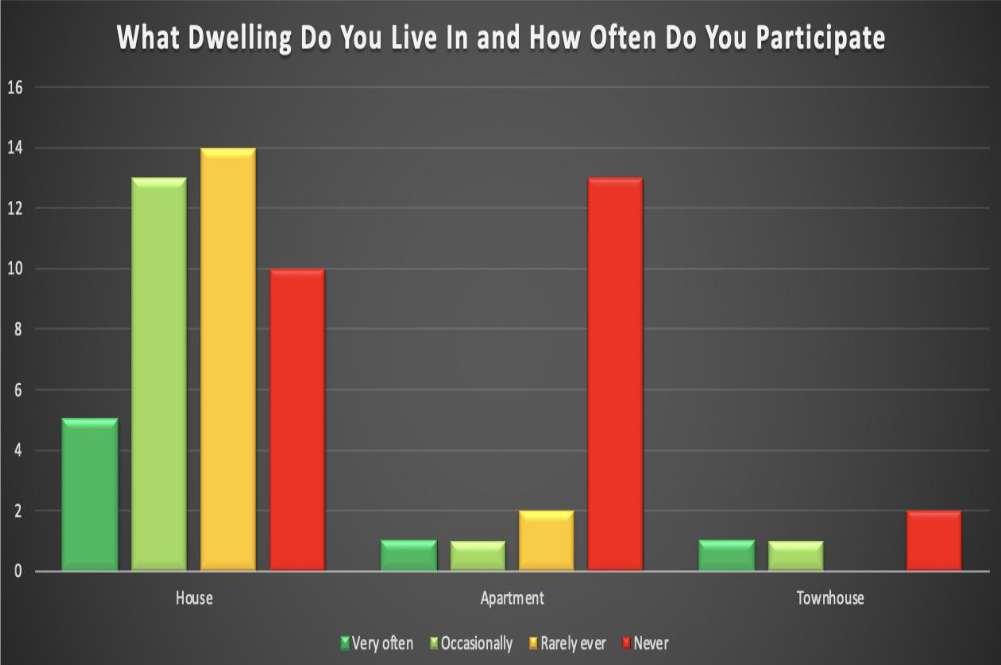
Graph 2 suggests that different social and situational factors influence residents’ participation in the community and, specifically, that the type of dwelling has a major connection to not only participation rates in the community but these interpretive residential affiliations are critical to dwelling identity. This assumption is supported by the evidence by Cuba and Hammon (2009) that indicate how various types of settlements are associated with the formation of place ideology as well as shared values and interests. Our data only supports this point: the overwhelming majority of apartment dwellers never engage in community activities while the frequency with which house dwellers do ranges from very often to rarely ever.
The participants with the lowest community participation belong to two demographic and socioeconomic groups – ages 24-39 and apartment dwellers. Their disengagement may be explained by their transient tenantship, which makes it impossible to become strongly attached to one place. Another possible explanation is the isolating nature of high-density living, as described by Saeggert and Winkel (2004). Graph 1 and Graph 2 show that it is the social group consisting of homeowners between the ages of 50 and 59 that show the highest levels of community participation. In this regard, our findings are consistent with those made by Brown et al. (2003).
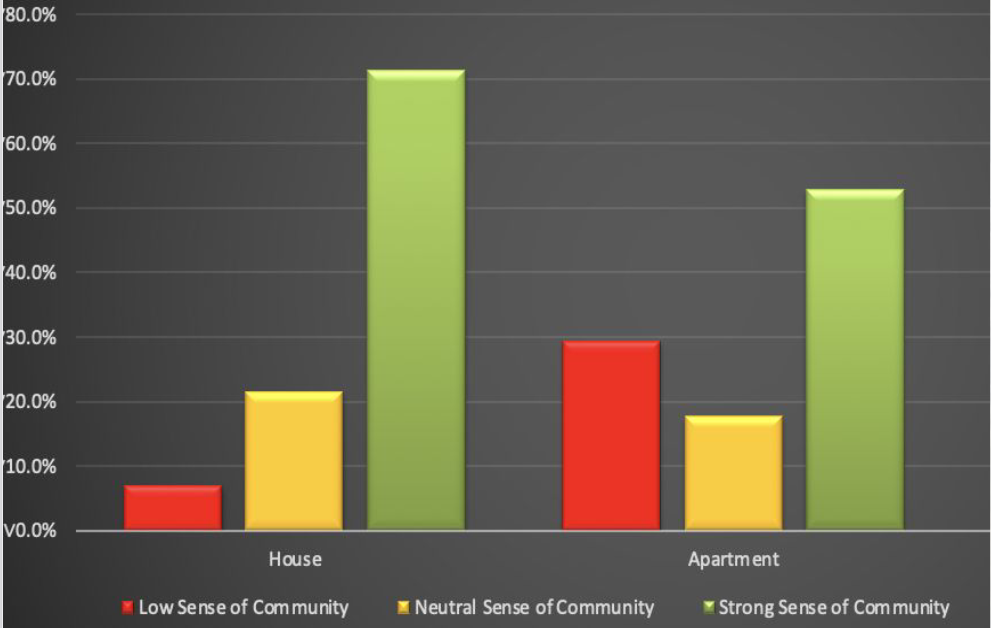
Graph 4 has shown that the house dwellers had a very strong sense of community and 70% of them were satisfied with their social encounters. Only 7% of them reported a low sense of community compared to 20% of residents living in apartments. In contrast to the literature review findings, the share of apartment dwellers experiencing a strong sense of community was not significantly lower than those living in houses: 70% and 50% respectively. Yet, the difference is tangible and may be explained by the density of apartment living that makes for isolated existence as outlined by Mullins et al. (2001). It becomes apparent that for house dwellers, a sense of community translates into action and active participation while the same cannot be said about apartment residents. It could be that residential buildings provided fewer shared space where people could meet each other.
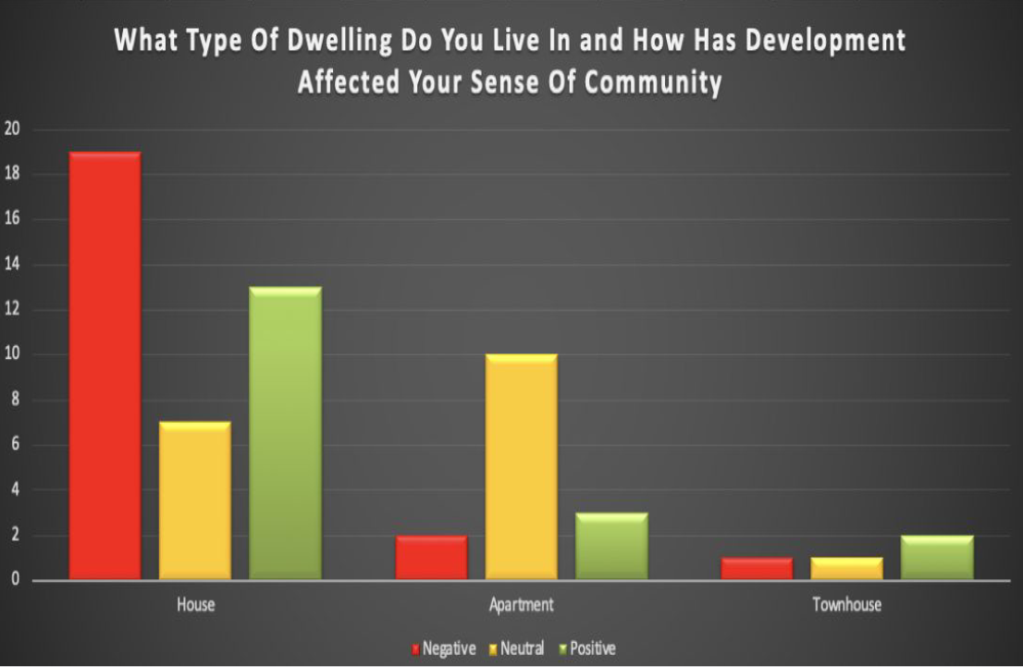
The majority of apartment dwellers (66%) did not report experiencing a significant increase or decrease in the sense of community associated with urban development in the area. Around 20% even considered the changes to be a positive turn of events, associating the urban growth with “more networks of people to interact with.” Only around 15% of residents living in apartments felt a decreased sense of community due to the Ryde suburb development. In contrast, only a minority of house dwellers had a neutral position with regard to the government’s urban planning initiatives. More than half of them were said that development was detrimental to their sense of community. As one of the respondents said: “While there’s a larger population as a result of the new housing developments, people are less inclined to interact with their neighbors because most are not family / or just not interested in those interpersonal connections.”
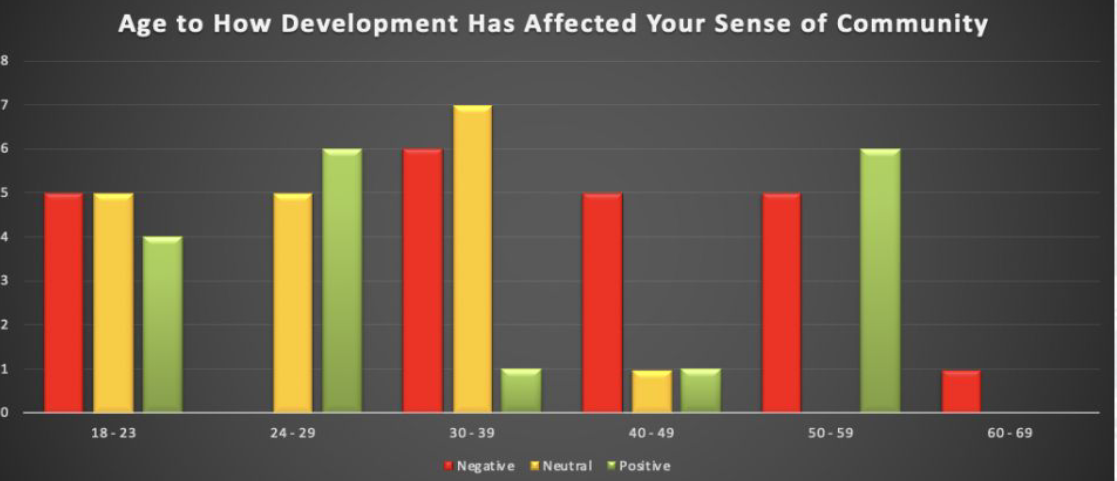
People aged 24-29 have an overall positive (54.5%) or neutral (45.5%) attitude that can be attributed to the cheap nature of the rentals, the ease of moving out, and the capacity of a large population to grow a community. Residents between the ages of 30-50 reported overall negative (30-39 42.9%) + (40-49, 71.4%) or neutral (30-39, 50%) + (40-49, 14.3%) attitude. The negatives were concerned with apartments, the strain on infrastructure, and the impersonality of a larger population. Lastly, the feedback from people aged 50-59 was split between positive (54.5%) and negative (45.5%). They appreciated the larger multicultural living but criticized too much noise, too many apartments, and infrastructure strain.
Conclusion
Today when the population growth, especially in urban areas, is faster than ever, it is community psychology that may help to understand how people interpret environmental cues and interact with the environment. High-quality neighborhoods have been found to serve as a protective buffer against social ills and public health concerns. However, the maintenance and development of a community largely depend on the voluntary activities of its residents. The sense of community is a useful concept and a variable that predicts both residential satisfaction and community participation. Certain demographic and socioeconomic factors make place attachment more likely. It has been found that older people and homeowners have a stronger sense of community and regularly engage in community activities. Younger people’s mobility and the spatial planning of residential areas that they choose often discourages participation and does not facilitate forming a close connection to the place.
Reference List
Abass, ZI & Tucker, R 2018, ‘Residential satisfaction in low-density Australian suburbs: the impact of social and physical context on neighbourhood contentment’, Journal of Environmental Psychology, vol. 56, pp.36-45.
Australian Bureau of Statistics 2016, 2016 census quick stats. Web.
Brown, B, Perkins, D, & Brown, G 2003, ‘Place attachment in a revitalizing neighborhood: Individual and block levels of analysis’, Journal of Environmental Psychology, vol 23, pp. 259-271.
Buys, L & Miller, E 2012, ‘Residential satisfaction in inner urban higher-density Brisbane, Australia: role of dwelling design, neighbourhood and neighbours’, Journal of Environmental Planning and Management, vol. 55, no. 3, pp.319-338.
Chavis, DM & Wandersman, A 2002, ‘Sense of community in the urban environment: a catalyst for participation and community development’, in A Quarter Century of Community Psychology, Springer, Boston, MA, pp. 265-292.
Commonwealth of Australia 2016, Current urban planning and management. Web.
Darlaston-Jones, D 2007, ‘Psychological sense of community and its relevance to well-being and everyday life in Australia’, Australian Community Psychologist, vol. 19, no. 2, pp.1-25.
Fuller, K 2019, ‘Reshaping the ‘boomburgs’: Minister takes on challenge of managing Sydney’s urban sprawl’, ABC News. Web.
Lee, RE & Cubbin, C 2002, ‘Neighborhood context and youth cardiovascular health behaviors’, American Journal of Public Health, vol. 92, no. 3, pp.428-436.
Mullins, P, Western, J, & Broadbent, B 2001, ‘The links between housing and nine key socio cultural factors: a review of the evidence positioning paper’, Australian Housing and Urban Research Institute, Queensland Research Centre, pp 1-53.
Ritchie, H & Roser, M 2019, Urbanization. Web.
Saegert, S & Winkel, G 2004, ‘Crime, social capital, and community participation’, American Journal of Community Psychology, vol. 34, no. 3-4, pp. 219-233.
Scuderi, CS 2005, The meaning of health and the expérience of coronary heart disease in Italian-speaking cardiac patients: Implications for cardiac réhabilitation programs, Doctoral dissertation, Victoria University. Web.
Smith, KM 2011, The relationship between residential satisfaction, sense of community, sense of belonging and sense of place in a western Australian urban planned community, PhD Thesis, Edith Cowan University. Web.
